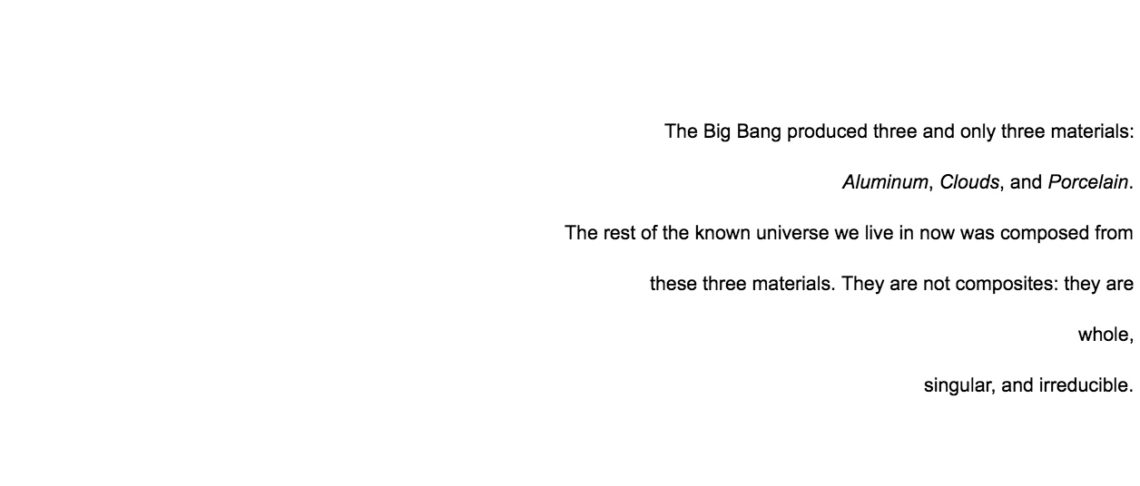A message from the editor…
How time passes, and how time is felt passing, how time is personal and ever changing its costumes and definitions. Within that what is a moment. Within that what is an event. What is shared, and with whom and what else. What is taken away. What might grow. What of all this is perceived.
We close out this series on sound and time for now with an essay that manages remarkably to provoke and convey the sense of time’s tricks and trades, how artists use that, how life might present it to us, how we may consider. With the delicacy and strength of a silk thread, this essay flows. I highly recommend multiple reads, it changes with the changing light.
.
.
.
.
.
In loving memory of my father, Aaron Daniel Hertz, 1945 – 2018
.
.
How can sound or words transcribe this imperceptibly slow transformation occurring during every instant and that only an extremely attentive and alert eye can sometimes perceive, the movement of a leaf, a stalk, a flower propelled by the life that makes it grow.
–Éliane Radigue: “The Mysterious Power of the Infinitesimal” 1
.
.
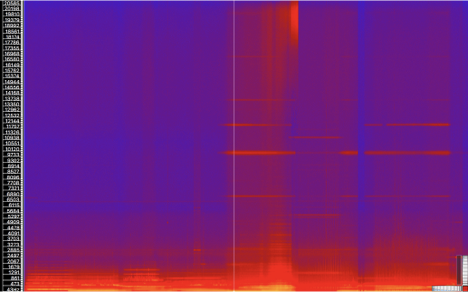
Spectrogram display of Kyema (Comp. Éliane Radigue) 2
.
.
Composer and electronic music pioneer Éliane Radigue prompts us to imagine an aesthetics of the infinitesimal—the development of a faculty of seeing and hearing that extends into the microscopic. Buried within this urge for a slower practice of auditory discrimination is a more nuanced discretizing of moments. At a certain scale, it makes sense to speak of these transient moments using terminology like Attack, Decay, Sustain, and Release. At another scale, it would simply do to speak of a particular accent, a crescendo, a decrescendo. Either way, we understand these as moments in-and-of-themselves, possessing a unique character unencumbered by (or at least ambivalent toward) impermanence. Radigue’s insistence on the processual nature of transient moments undercuts a more discretizing philosophy of events, focusing instead on the notions of instability, consistent transformation, and growth. The Moment itself is constantly in-flux, definitionally transitory. While the ecological language Radigue employs trends towards the utopian, we can also understand this futuristic micro/macroscopic lens as enabling us to see in the reverse, not what will be but what once was. Noticing with more clarity—and with greater magnitude—the forces and scales of precarity and disappearance.
The range of disappearances I concern myself with involves the gradual occulting of presence: the slow leaks, the centuries-long fade-to-black. In this case, sonorous as well as biological disappearance, the change of soundscapes that accompanies drastic and destructive climate change. Yet, much of the signaling of these violent changes occupy a particular range of the ‘invisible’—existing at scales, tempi, and orders of magnitude lesser/greater than those at which we are accustomed to hearing, seeing, and feeling. A particular range of the invisible that renders them benign, or perhaps even naturalizes them—obscured to a degree only visible once it is too late.
Therefore, how is it that we can recognize the slowness of transformation—the quietude of loss—before the crossing of grave (yet sometimes still silent) thresholds?
Here, I use the pacing and spectral metamorphoses of Radigue’s work as an entry point to acclimatize ourselves to the sonorous transformation and evanescence of bioenergetic materia.3 To take each of these auditory events and durations as significant ones, no matter the tempo. And to notice, if we can, the minute details of transformations that lead to loss.
.
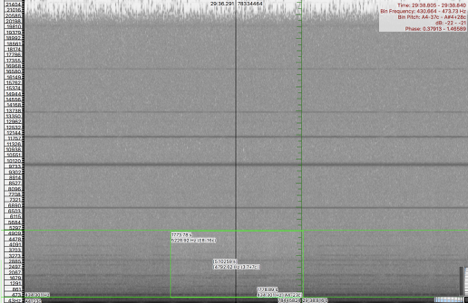
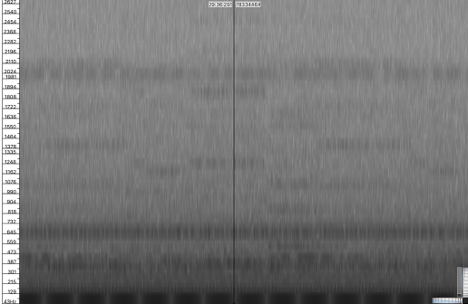
.
It would benefit us to begin with a discussion of what it is that comprises a Moment by way of considering scalings of human thought and perception.
The world never feels fallen, because we grow accustomed to the fall. 4
As biodiversity professor Kevin Gaston explains, “‘humans seem innately better able to detect the complete loss of an environmental feature than its progressive change’”—indeed, a main problem of addressing anthropogenic climate change is the capacity for humans to understand large-scale change over time.5 At the heart of the matter is the problem of scale itself: the measurements of human lifetimes—not to mention the timescales at which our daily lives are lived—often cause issues in conceptualizing either long-term or particularly nuanced challenges.6 Large, clearly observable effects of changing climates, for instance, often happen after it is ‘too late.’ Otherwise, small-scale predictors of large-scale events simply pass us by, sitting below the thresholds of detection. In either direction, the scales at which we have the greatest degree of sensuality allow plenty of events to evade notice. Not for any lack of significance—simply because there is a mismatch between event durations and the baseline scales of our perceptive faculties. While problems of scale might seem to be an obstacle at first glance, it is my contention that—by way of prompts by sound artists and ecoacousticians alike—we are capable of re-scaling hearing, feeling, and seeing to perceive nuanced events at magnitudes larger and smaller than that of which we might be ‘naturally’ capable. In some sense, this prompts a return to a (most likely) imagined listening scenario inspired by a pre-Capitalist ontological lens—at the same time, I advocate for a listening which is unabashedly contemporary. It is precisely because of advancements in scientific listening technologies, and sound-producing technologies in the tradition of experimental electronic music, that enable new vantage points into the micro/macro-agogic moment.

Further, the idea of micro/macro-agogic moments is one we will take forward with us, as it foregrounds possibilities for conceptualizing extensions of the perceptive scales with new understandings of what we mean by a Moment.
.
Is the future a stacking of projected presents?
Is it inferred by an accumulation of transitory moments?
Is it a practice of intuition, or is it always a thought-experiment?
.
We arrive now at the idea of a Moment or an Event, a discussion of which gives us an entry point into ideas of hearing histories and projecting futures. In their article “Attentional entrainment and perceived event duration,” J. Devin McAuley and Elisa Kim Fromboluti discuss the positive laboratory tests of what they label Dynamic Attending Theory (DAT)—assessing the weight of context on the perceived duration of events and the extent to which “attentional oscillations are entrained by the rhythm of the context sequence.”7 In the experiment, participants are asked to give attention to audible tones played in rhythmic sequences at different tempi. Interrupting the sequence at one point is an ‘oddball’ event consisting of a different pitch and occasionally a different duration than the control tones. The participants are then asked to give approximate timings to the duration of the ‘oddball’ tone. Testing multiple variations of sequence and tempo, the study concludes that in the majority of cases, calculated event durations are “influenced by the phase of its onset relative to the expected time points based on an extrapolation of the context rhythm,” that durations of oddball events are warped with relation to higher-tier rhythmic patterns.8 Momentary event perception is entrained within, and therefore dynamic due to the context of longer-phase event cycles. Not only is our interior idea of a moment dynamic, but it is predicated on schematizing larger groups of events, and is therefore expressed through a projection of futurity.
Event patterns—whether truly ‘rhythmic’ or not—establish rhythmic traits that color the amounts of attention (and therefore timing, among other elements) we give to events happening in the interim. In other words, momentary event perception is fully involved in the establishment of longer patterns of perception. Whether we are able to comprehend the meta-scalings of these larger cycles is a subject left for another study, but suffice it to say for now that we use rhythmic consistency (or non-consistency, as the case may be) to extrapolate and scale event durations smaller than it.
According to McAuley and Fromboluti—as well as past researchers in Scalar Expectancy Theory (SET, a more ‘discretizing’ approach to momentary event perception and cognition)—momentary evaluation is governed by an interior “clock stage, which consists of ‘pacemaker’, ‘switch’ and ‘accumulator’ components. The pacemaker generates a continuous series of pulses,”—the ‘baselines’ of the perceptive event, which are then collected by the accumulator.9 The key difference between DAT and SET is that SET researchers maintain the possibility for a discrete evaluation of each event, while DAT-aligned researchers insist on the fluidity of the pulses with respect to a greater event-cycle context. As an overall model then, we have a higher-order rhythmic scale which has the potential for dynamically orienting the pace of smaller pulses.10 And therefore possess an accumulator that is sensitive enough to receive pulses in these reconfigured scales, and in a way that can assign relative, yet self-consistent timing.
[youtube https://www.youtube.com/watch?v=8hHPAp32emc&w=560&h=315]
The notion of dynamic pulses as the baseline of perceptive schema finds itself as strange bedfellows with composer Karlheinz Stockhausen’s approach to perceptual schema across time using the word ‘phase’ (defined by Stockhausen as the basic unit of perception) in his article “. . . . . HOW TIME PASSES . . . . .” Discussing phase from the standpoint of notational duration, Stockhausen remarks that “the transition from one time-area to another causes a change in our perception of phases.”11 Of course this causes a mathematical change in the literal length of phases (with regard to rhythmic units), but here Stockhausen primarily emphasizes the notion of its perception rather than the mathematical equivalencies that go on to be a more prominent aspect of his article. What we can understand from this stems exactly from the title of the article itself: the ways in which “TIME PASSES” depends precisely on the notion of “time-area”—a context-driven ‘Global Time’ influencing the passing of time with reference to event duration timing.12 Broadly then, our sense of event duration is a function of the environmental oscillations that entrain our interior rhythmic projections of future events based on a heard understanding (or at least assessment) of history. Infinitely flexible, our interior event cycles would seem to possess a dependence on external, longer period rhythmic environments.
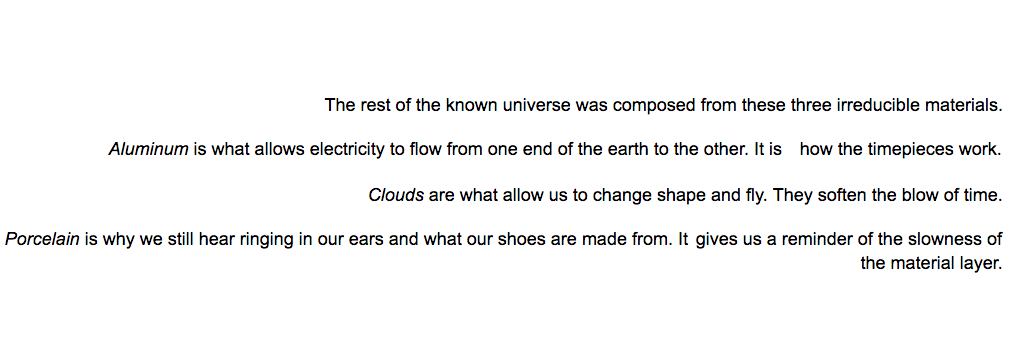
Having established here the idea of dynamic event perception based on hearing histories, I can further say that no matter how nuclear we can scale our understanding of moments, we never feel these pulses—our so-called Pacemakers and Accumulators are invisible. These Pulses are only as tangible as the concept of a moment itself. Nevertheless, we can understand them as comprising an overarching conceptual model. I suggest that considering DAT as a model for environmental thinking might contain a greater appreciation for the entraining, environmental rhythmic context. When we realize that perceptive schema can be scaled up to entrain with dynamic environments—at the scale of dynamic environments—we might be able to extend this idea to create dynamic sensitivities to multiple scalings. A sensual interior pulse that grasps at the increasingly infinitesimal scales marking the early stages of disappearance—of more and more abandoned nests, or a gradual shift to a different song that falls on deaf ears.
Brooke Jarvis’ recent New York Times article entitled “The Insect Apocalypse is Here” is an apt case-study on the ‘sensible infinitesimal,’ highlighting an approach to disappearance that bridges sensuality with intuition. Jarvis’ main characters in this multi-pronged story about the steady, world-wide decrease in insect populations hover around the point articulated by entomologist David Wagner:
“We notice the losses,’ says David Wagner… ‘It’s the diminishment that we don’t see.’ (…) Because insects are legion, inconspicuous and hard to meaningfully track, the fear that there might be far fewer than before was more felt than documented. People noticed it by canals or in backyards or under streetlights at night—familiar places that had become unfamiliarly empty.13
There is already a feeling associated with loss, however not always so clearly articulated through data. This pulse of feeling, however, has the cyclic span of a full generation—an adult’s remembrance of a noisier time: the tactile unavoidability of this chattering and chirping biomass. If we cared to listen, we might hear (or might have heard) this slow disappearance as well—a creeping decrescendo of insect life, or a ever-so-gentle crossfade of biophony into anthrophony and technophony.14 Hearing absence is a funny thing; it is always harder to hear a hole than an intruder. And because of the longer scales of time involved in these disappearances, the body falls victim to “shifting baseline syndrome”—the almost-too-casual adjustment of the ear to a consistently diminishing bed of sound.15 For it will never be that case that we wake up to a silent world, only ever-increasing Radigue-ian crossfades crawling towards zero but never arriving.
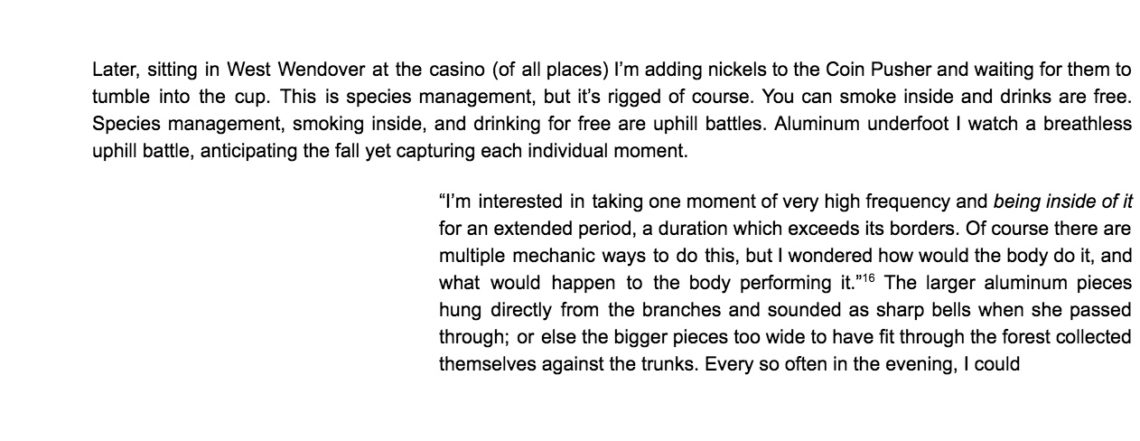
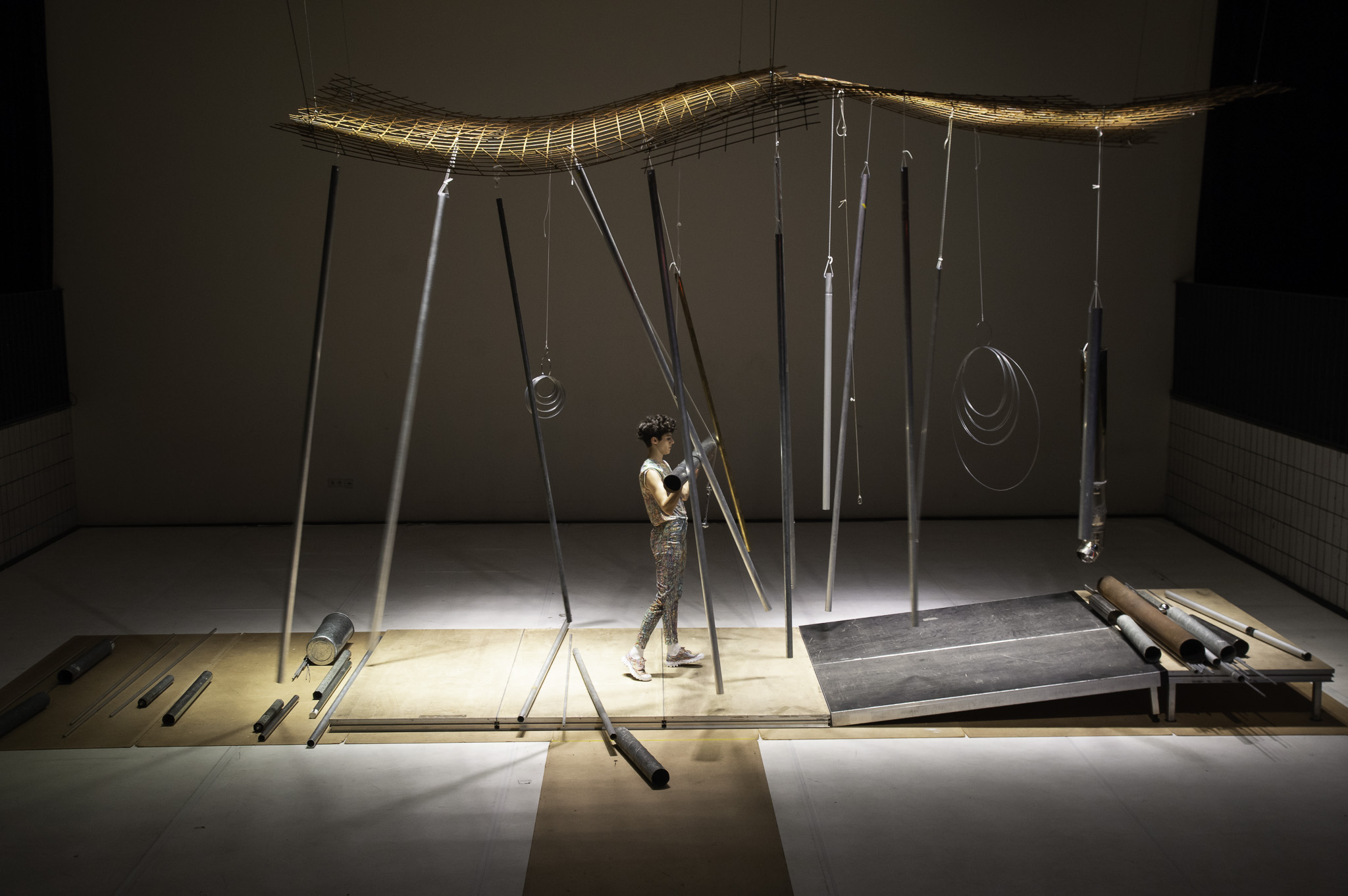
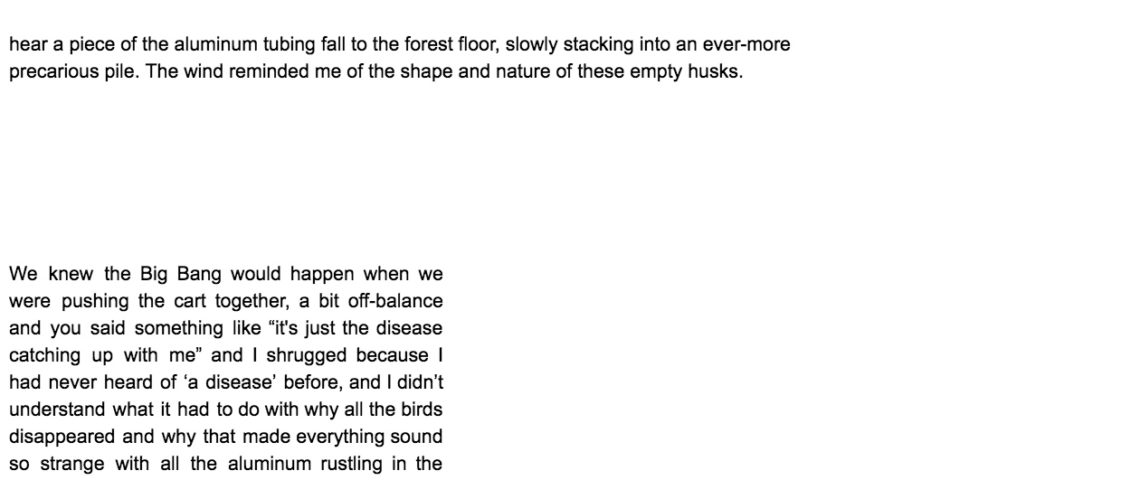
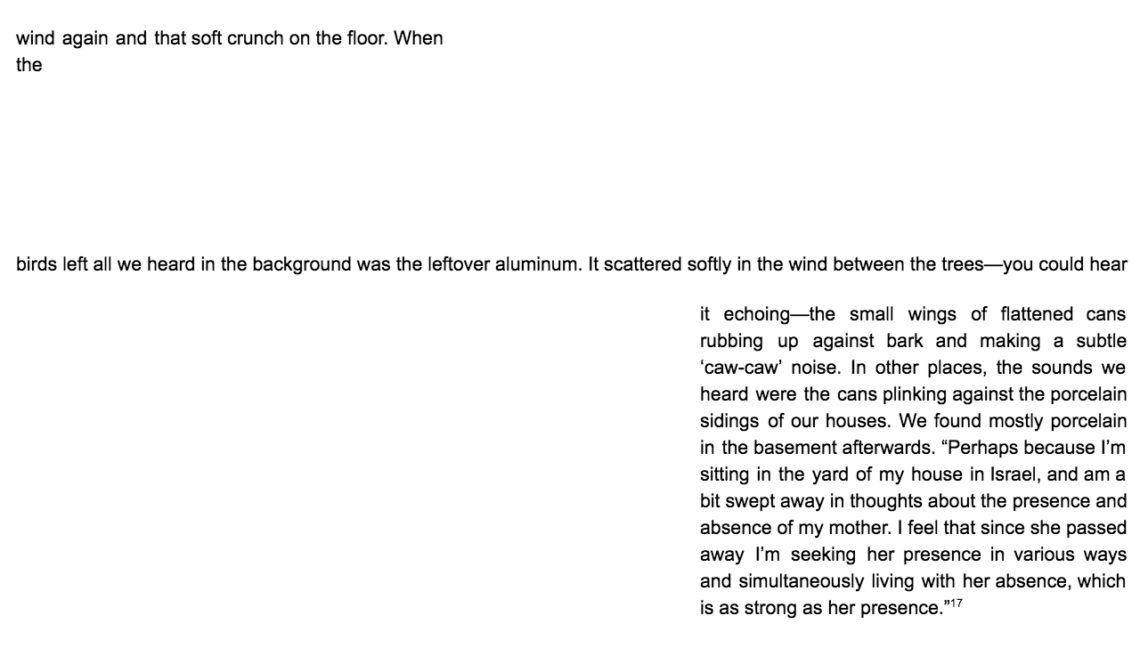
In truth, there is no good way to ‘hear absence’ until it is already there. We may have the sense that something is missing, but then, isn’t it the case that it is already gone. And what to do with the overwhelming feeling of the presence of absence, such as that which Meir articulates: the bizarre weight of an empty space which can never truly be covered. Wherein lies the possibility for sensing impending loss?
Acknowledging of course the true violence of climate genocide: that it has already started (if you care to look and hear). What’s not as abundantly clear is how far into the fall we already are.
.

We can imagine a situation where a strong melt slowly drowns out these streaking signals, acoustically drowned under water.
Clangula hyemalis recorded near Seyðisfjörður, Iceland
20 December 2018, 12:43pm
This prompts a turn towards the fields of bioacoustics, ecoacoustics, and soundscape studies, where we can hear the echoes of infinitesimal listening articulated within the wide variety of sound-based studies of shifting climates and shifting histories. And rejoining Jarvis’ indications of rapidly waning insect populations, we can discover that a multitude of important data regarding the various changes, transformations, and losses associated with climate change within the acoustic communities of the animal world may be heard before they are seen. Felt before measured. The idea, however, is to create perceptive toolkits wherein measuring and feeling are the same. Where “Feelings are Facts.”18
The most obvious and violent effects of stress on climate conditions are indeed loss—the not-always-so-slow decimation of communities due to loss of resources, forced relocation, closer proximity to previously non-threatening predators, and so on. While these clear extinction markers make up a large percentage of the ‘face’ of climate change, sound studies allows us to make the infinitesimal perceptible, creating more nuance in the way we hear sonic ecologies, as well as providing new analytical frameworks within which augmentative and destructive properties of climate change may be noticed before large-scale, drastic extinction markers.
Looking at the long-term scales of climate change, we often gloss over the day-to-day aspects of climate violence. Whether they affect rising sea levels, temperature fluctuations, or in/decreases in precipitation, shifting climates modify “daily atmospheric dynamics”—the daily lived experience of human and non-human animal communities affected by climate violence cannot be overstated.19 And within these lived experiences we find subtler, yet no less indicative, evidence of climate shifts expressed not necessarily through loss writ large, but through changes of habits and cycles: mating periods may begin to shift earlier in the year with faster and earlier transitions from Winter to Spring; migration patterns may begin to overlap due to earlier occurrences of severe Winter weather patterns.

Simultaneously, we see hypotheses such as Bernie Krause’s ‘Acoustic Adaptation’ which maintains that ecological elements affect the development of the acoustic abilities of species living within those ecosystems. This hypothesis sets out to predict a.) how the acoustic abilities of a given species develop in the first place, and b.) the ways in which acoustic abilities adapt to changing habitats. What can be inferred by this hypothesis is the fact that as the climate changes due to human influence, we may also notice acoustic adaptation in the songs, calls, and signals used by animal inhabitants of these altered climates. This is to say, not only do changing climates cause acoustic holes in the most drastic example of loss, but they also cause shifts in the types of sounds that are made, how the sounds propagate, and how the sounds are received. In Krause and Farina’s 2016 paper “Using ecoacoustic methods to survey the impacts of climate change on biodiversity,” a host of bioacoustic adaptive response examples are given including: “decrease of bandwidth… across geographical range with the increase of atmospheric absorption” in North American warblers and changes in “sound transmission in marine systems due to acidification.”20 Not only this, but changes in the calls and responses of animals within a given ecosystem affect not just the well-being of their particular community, but may interfere or disrupt communication networks of other species—crossing wires. Krause and Farina speak of the isolation of each communication channel using Krause’s Acoustic Niche Hypothesis explaining that, “the voice of each organism in a given habitat strives for its own bandwidth—a clear channel of transmission and reception—to avoid masking, much like instruments in an orchestra are organized.”21 Therefore, when animals are forced to make alterations to their communication channels due to environmental effects, we may begin to see frequency-space crossings, overlaps, and masks, potentially causing animals to continually change and adapt calls and signals, or to otherwise not be heard.22 And as animals begin to make adaptations to the ways they communicate, we will have already lost the subtleties of current sonic environments—the songs and calls that make our relationship to specific environments so distinctive and unique, lost to history.
A nuanced look at bioacoustics in both the short- and long-term show us that spectral transformation of soundscapes are a clear precursor to terminal disappearance. And further, this means that a nuanced look at shifting bioacoustics signatures is a task fitted for infinitesimal listening—it is possible at least that we may hear the slow, shifting timbre of the call before we see the sheer numbers drop. The way one slurs their speech in their last days. This type of listening may be able to signal the first sign that things are already slipping past thresholds underneath our ears.


This idea backgrounds Adriana Petryna’s discussion of the ‘Invisible Present’ “as a new kind of experimental medium—a meso-space of experimental time,” as a fluctuating space of multiple temporal and spatial perspectives; and ‘Horizoning’ as a methodology attempting to reconcile these uncertain perceptive spaces in between ‘abrupt’ events and long-period changes.23 Through a discussion of Stephen Carpenter’s “one-way trip” approach to climate models24 Petryna stresses the importance of assessing environmental transformations at multiple scalings in order to encourage more robust, ‘coeval’ thought as a means to “regain proximity to ecological phenomena that are unstably configured, unfamiliar, or under stress.”25 Similarly, as Stefan Helmreich relates in his account of geoscientist Satish Singh’s talk to the InterRidge Conference, “By asking, ‘What shall we do?’ as computer models replayed the path of the [26 December 2004 Indian Ocean tsunami], Singh came closest to calibrating the scale of science to the scale of recent history and, indeed, to a temporality in which not everything was under control… Singh’s talk came closest to summoning up the uncertainties in scale…”26 Singh’s juxtaposition (or rather complimenting) of human, oceanic, geologic, and bureaucratic temporalities articulates Petryna’s “meso-space of experimental time” a concerted perceptual effort to bridge temporalities and scales to hear with greater clarity the interactions, transformations, and constituent parts of large-scale events.27 Weaving together personal experiences and “pictures of people fleeing from the waves” with data animations and questions of bureaucratic response, Helmreich notes that Singh’s talk deftly highlighted the notion that scientific inquiry (and response) cannot be separated from the experiences of living through a changing climate.28 Ecoacoustic work strives for a similar type of literal and conceptual broadband analysis—searching for ways and means to bridge the echoes of loss with the slow spectral tilting of recent histories.
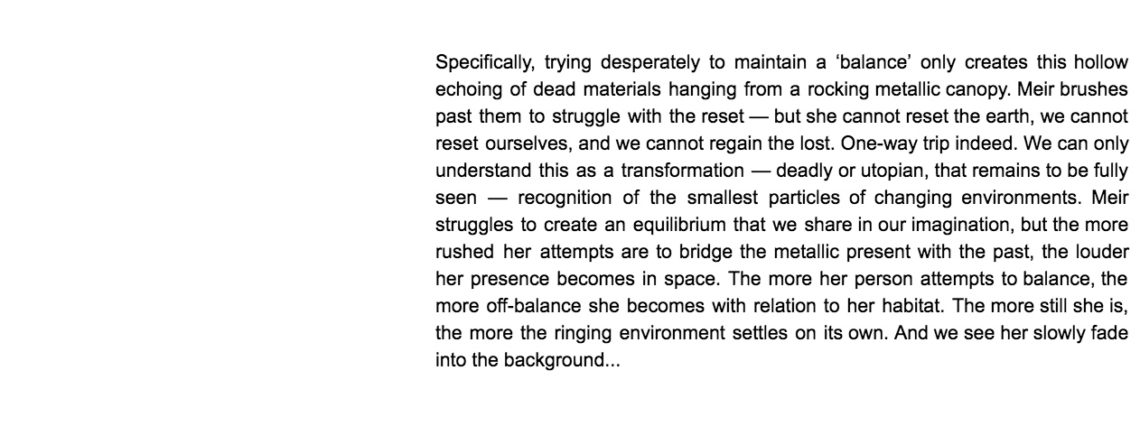

Choreographer/Performer: Lee Meir
.
To listen to Radigue’s work itself is an embodiment of the same slow and deliberate nature with which it is created. A performative composition wherein adjusting “a potentiometer [by] the volume of a hair could change everything,” and by which, every volume of a hair is a unique, extensible moment.29 In Kate Molleson’s illuminating interview with Radgiue, Molleson discusses the extent to which the “sense of time in her [Radigue’s] work is both contracted (to provide a minutiae of detail) and elongated (to allow the work to unfold over many hours). ‘By nature slowness is expansive, yet it allows us to hear up close.’”30 Radigue and Molleson’s articulation of the progression of time directly corresponds to the dynamic and extensible nature of momentary perception imagined earlier. An event contains both elements of long- and short-term durations, and further (according to Radigue), these timescales do not contradict. It is in fact the magnitude—the intensity of the slowness—that allows us to see increasingly smaller and smaller traces. “The Mysterious Power of the Infinitesimal” indeed. The mysterious power, however, is not necessarily related to seeing discrete, small events. Rather, the infinitesimal is part of a stratified process—diving deeper (smaller), we find “Another level, another theme begins.”31 To read Radigue’s version of the BIG BANG is to see her version of the development of scales of sound, fluidly linking large, catastrophic events of earth, atmosphere, ocean, and fire, to their constituent (or accumulative) elements—water droplets, heat, surf, organs.
Radigue’s ordering of the world through sound embodies a position between the exoteric and esoteric: a perspective bridging surface intensities and structure with internal motion and the infinitesimal experiential.32 To see the changes of sound behavior buried within climate changes. To understand the durational oscillations of large events as ordering as an awe-inducing invitation to imagine our attention oscillating in concert.
To dig into the infinitesimal is to realize that significant layers lie underneath and above—an adjustment of our perceptive lenses warrants a re-evaluation of the sonic world around us, as well as the lived life that the sounds expose in-turn. A ‘Horizoning’ of the sonic spectrum. And hearing the infinitesimal also allows for an understanding of new rates and dimensions of transformations of sounds, habitats, and climates.
Perhaps it’s actually not death itself, but rather the process of dying, of accompanying someone who is leaving this world. You understand that you don’t actually have full control of anything. This brings great pain but also a beauty, not only because it makes you re-evaluate everything but also because it invites you to see things as they are, in a certain everlasting present tense.33
What we’ve left behind are the layers of loss, of precarity, of transformation, and of growth—the invisible present which constantly escapes our audition, our view, and our feeling. Understanding infinitesimal listening as an approach, then, towards not only expanding and contracting temporal perspectives (as we might widen a net), but focusing on the interrelation of the new material of which we catch glimpses. For, it is not only the ‘capture’ of more information that extends the possibilities of this type of listening—instead, it is the ability to work through the complex and perhaps contradictory indications of political, ecological, lived, and sounded timescales that intersect within our attempts to ‘read climate.’ We may never be able to hear 1,001 years34, but perhaps we can step into it. We may never be able to see directly into the future but perhaps we can hear the infinite amount of moments passed on the way there.
.
.
This is how I heard the Big Bang last spring.
.
This is how I taught myself to catch the aluminum falling from the trees…
.
.
.
Endnotes
1. Radigue, Éliane. “The Mysterious Power of the Infinitesimal.” Leonardo Music Journal 19 (December 2009): 47–49. https://doi.org/10.1162/lmj.2009.19.47.
2. Radigue, Éliane. “Kyema, Intermediate States.” Kyema, Intermediate States (1990). Experimental Intermedia Foundation.
3. Literally, perhaps.
4. Jarvis, Brooke. “The Insect Apocalypse Is Here.” NYTimes.com. https://www.nytimes.com/2018/11/27/magazine/insect-apocalypse.html (Accessed December 2018).
5. Ibid.
6. I use here Richard York and Philip Mancus’ (2009) definition of scale as: “the spatial, temporal, quantitative, or analytical dimension used to measure and study any phenomenon.” quot. York, Richard, and Philip Mancus. “Critical Human Ecology: Historical Materialism and Natural Laws.” Sociological Theory 27, no. 2 (June 2009): 122–49. https://doi.org/10.1111/j.1467-9558.2009.01340.x.
7. McAuley, J. D., and E. K. Fromboluti. “Attentional Entrainment and Perceived Event Duration.” Philosophical Transactions of the Royal Society B: Biological Sciences 369, no. 1658 (November 10, 2014): 20130401–20130401. https://doi.org/10.1098/rstb.2013.0401. p. 2
8. Ibid. 2
9. Ibid. 2
10. Meaning here, more or less continual without necessarily being either repetitive or regular.
11. Stockhausen, Karlheinz. “How Time Passes By.” Die Reihe Vol. III (English). 1959. p. 11
12. An appropriately named aspect of time-keeping—most commonly found in Digital Audio Workstations and electronic music software—responsible mainly for keeping a system-wide master time counter through which all smaller events have a standard of measurement.
13. Jarvis 2018 (emphasis mine)
14. Lomolino, Mark V., Bryan C. Pijanowski, and Amandine Gasc. “The Silence of Biogeography.” Journal of Biogeography 42, no. 7 (July 2015): 1187–96. https://doi.org/10.1111/jbi.12525.
15. Jarvis 2018
16. Lee Meir on Line Up @Uferstudios, personal correspondence.
17. Lee Meir, personal correspondence.
18. Rainer, Yvonne. Feelings are Facts: A Life. Boston: MIT Press, 2006.
19. Krause, Bernie, and Almo Farina. “Using Ecoacoustic Methods to Survey the Impacts of Climate Change on Biodiversity.” Biological Conservation 195 (March 2016): 245–54. https://doi.org/10.1016/j.biocon.2016.01.013.
20. Krause & Farina 247.
21. Krause & Farina 247, ref. Krause, Bernie. “The Niche Hypothesis: A virtual symphony of animal sounds, the origins of musical expression and the health of habitats.” The Soundscape Newsletter 06 (June 1993).
22. Not to mention the fact that warming climate means a making-habitable of some climates which were previously inhabitable — this creates new contact zones between species which may not have previously been in proximity, potentially leading to problems of communication overlap, not to mention predation and resource use.
23. Petryna, Adriana. 2017. “Horizoning” in Unfinished: The Anthropology of Becoming, edited by João Biehl and Peter Locke. 243 — 268. Durham and London: Duke University Press.
24. The notion that habitats do not ‘reset’ themselves to previous states of equilibrium, but simply adapt and move ahead. The Earth itself has no singular stable state, only the ability to exist in one of many states of constant change.
25. Petryna 258
26. Helmreich, Stefan. Sounding the Limits of Life: Essays in the Anthropology of Biology and Beyond. 2016. Princeton, NJ: Princeton University Press. 113
27. Petryna 251
28. Helmreich 113
29. Radigue, Éliane. Occam Ocean. https://www.aguirrerecords.com/products/eliane-radigue-occam-ocean-vol-1-2xcd
30. Molleson, Kate. “Interview: Éliane Radigue.” katemolleson.com, http://katemolleson.com/interview-eliane-radigue-2/ (Accessed December 2018).
31. Radigue (2009) 47
32. Wilson, Eric G. The Spiritual History of Ice: Romanticism, Science and the Imagination. New York, NY: Palgrave Macmillan. 2003. 3
33. Lee Meir, personal correspondence.
34. Amacher, Maryanne. “Step into it, Imagining 1001 Years, A- (Excerpt)” on Sound Characters. Tzadik. 1999.
.
.
.



